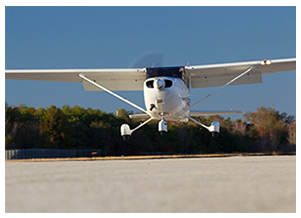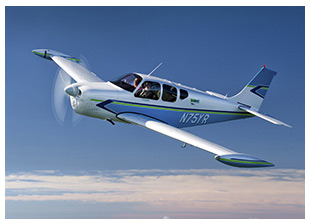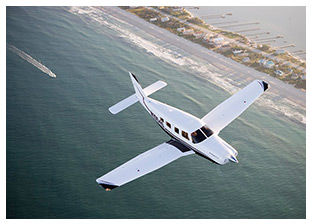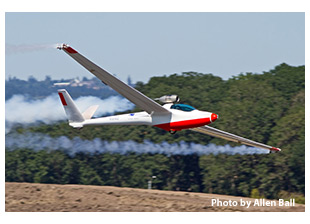Training Tips
|

Too good on takeoff
A student pilot is landing a single-engine trainer during a session of checkride prep. Airspeed is a few knots too high, however, and as the slippery ship enters ground effect, it floats and floats before finally settling down gently, in the proper landing attitude.
Not a checkride-perfect landing, but a fair demonstration of correcting an error with judgment, patience, and a light touch.
Same day, different airport: A heavily loaded four-seater is departing from a runway high in the mountains. It's a hot day, but the aircraft becomes airborne at a surprisingly low airspeed, delighting the pilot with its responsiveness despite the high-density-altitude conditions.
The euphoria dissipates when the aircraft is unable to climb away. With the runway's end and the tall trees beyond looming ahead, efforts to coax the aircraft to climb produce responses the pilot recognizes as those experienced during sessions practicing flight at minimum controllable airspeed! (But those sessions took place at a comfortable, safe altitude, not down here above a rapidly receding runway.) Unable to climb, and unable to lower the nose to accelerate without contacting the ground, he is in a spot.
New pilots usually become aware of ground effect when learning to land; they learn to take advantage of its sensory cues and aerodynamic effects to pinpoint the aircraft's position above a runway when completing the landing. In such cases the reduction of drag from ground effect, occurring up to about a wingspan above the surface, is your ally. But ground effect can compound airspeed imprecision, leading to floating and using additional runway during a landing.
Ground effect is also a factor on takeoffs. The conventional soft-field takeoff technique calls for the aircraft to be coaxed to fly as early as possible and then accelerated to safe climb airspeed in ground effect. Ground effect must be managed on normal takeoffs, too.
"Due to the reduced drag in ground effect, the airplane may seem to be able to take off below the recommended airspeed. However, as the airplane rises out of ground effect with an insufficient airspeed, initial climb performance may prove to be marginal because of the increased drag," explains Chapter 5 of the Airplane Flying Handbook. Add in high, hot, or heavy conditions, and the airplane may be "unable to climb out of ground effect."
Never rush your initial climb; be sure your aircraft is as eager to fly as you are.
|
|
|
|
Flight Training News
|
|
Article
ATP Flight School has purchased a majority share of Higher Power Aviation, enabling the training provider to offer the FAA's new airline transport pilot certification training program course.
Read more...
 
Apps of the week
Check out five apps that help pilots with their flight planning duties.
Read more...
 

'Pilot' magazine feature
What began as a forlorn, underused 50-year-old Beechcraft Debonair at Connecticut's Hartford-Brainard Airport has morphed into a one-of-a-kind classic. Read about the sweepstakes airplane's transformation, and join or renew by July 31 to be automatically entered to win it and other prizes.
Read more...
 
Auburn unveils plans for aviation center
Alabama's Auburn University has announced plans to establish an aviation center that will serve as a focal point for instruction, research, and outreach, and also support the aviation and aerospace industries. The center will strengthen academic and research programs, recruit industry to Alabama, improve flight operations, and train and collaborate with other colleges and universities, particularly in workforce development efforts.

Social media
The Air Safety Institute's Facebook community has grown by close to 100,000 new "likes" in less than a year! The Air Safety Institute thanks you for your extraordinary support and desire to promote general aviation safety around the world. If you're not already part of the institute's growing Facebook community, join today and learn more about its safety programs.
Follow the Air Safety Institute on Facebook...
Garmin has expanded the reach of its Pilot app for tablet computers to cover the entire planet.
Read more...
 
|
|
|
Training Resources
|
|
Login required
A night flight with friends to your favorite airport restaurant can be a breathtaking experience. But flying at night requires that you plan well. Take this Air Safety Institute quiz to prepare.
Take the quiz...
|
|
Did you know that student pilots who join AOPA are three times more likely to complete their flight training? Membership includes unlimited access to aviation information by phone (800/USA-AOPA, weekdays from 8:30 a.m. to 8 p.m. Eastern time) or from Flight Training Online or AOPA Online. If you're not already a member, join today and get the pilot's edge.
|
|
|
AOPA Live
|
|
AOPA Live This Week
FAA Administrator Michael Huerta fielded questions about medical certification reform during a recent visit to AOPA headquarters. Hear it straight from Huerta, and then travel with AOPA to Kenya, where American pilots volunteer to help stop poachers. Also this week, get a sneak peek at what's in store at EAA AirVenture, and fly the PBY-5A Catalina with Barry Schiff.
AOPA Live This Week®, July 24...
 
|
|
Career Pilot
|
Embraer predicts 6,250 new smaller jets
Embraer has released its market outlook for 2014 through 2033, which details the company's forecast for deliveries of new 70- to 130-seat jet aircraft over the next 20 years. The outlook identifies a need for 6,250 jets in that capacity category, with most in the 90- to 130-seat segment. Replacement of older aircraft will represent 56 percent of new deliveries, while 44 percent will support market growth. Embraer expects the world fleet of jets in service with up to 130 seats will almost double by 2033.
Pilots say no to cockpit cameras
Cameras in airline cockpits could augment data from cockpit voice and flight data recorders, providing additional insights for investigators, Wired said. The NTSB first proposed the idea in 2000, saying cameras "would provide critical information to investigators about the actions inside the cockpit immediately before and during an accident." But pilots opposed the NTSB proposal, calling it an invasion of privacy—and the airlines, which would have to pay for new technologies, were not eager to support it. Pilots said privacy safeguards don't always hold up, and they don't want to be judged based on a visual recording.
Article
Pilots pursuing a multiengine airplane airline transport pilot certificate should be clear on new requirements that will go into effect on Aug. 1.
Read more...
 
|
|
For more aviation career news, see the Flight Training website.
|
|
|
Plane Spotter
|

A symphony in V
With long, slender wings and a V-shaped tail, the Salto sailplane is a tantalizing tally—and a stunning sight performing overhead—for a plane spotter adding aerobatic gliders to an aircraft identification repertoire. If the Salto you spotted has managed to take off without towplane assistance, and the classical music to which it is performing seems to have been scored for jet engine and orchestra, the aerial performer must be Vertigo Airshows pilot Bob Carlton, flying his highly modified "Super Salto," powered by a 225-pound-thrust PBS TJ-100 jet engine.
|
Training Products
|
ASA releases new handbook
The latest edition of the Instrument Procedures Handbook is now available from ASA in print and e-book formats. Designed as a technical reference for all pilots who operate under instrument flight rules (IFR) in the National Airspace System, the handbook provides detailed coverage of instrument charts and procedures including IFR takeoff, departure, en route, arrival, approach, and landing. The cost is $29.95 for print and $24.95 for an e-book PDF.
Aircraft Spruce offers Oshkosh tower communications course
Just in time for EAA AirVenture, Aircraft Spruce is offering Oshkosh Tower/Aircraft Radio Communications on cassette tape and CD-ROM. The tape and CD-ROM were made from official FAA recordings made at the Oshkosh, Wisconsin, tower during an official EAA fly-in. The cost is $9.95 to $10.95.
|
|
Note: Products listed have not been evaluated by ePilot editors unless otherwise noted. AOPA assumes no responsibility for products or services listed or for claims or actions by manufacturers or vendors.
|
Member Benefits
|
|
Members only
Premature ventricular contractions (PVCs) are "extra beats" that originate in the ventricles of the heart. They can either be benign or a sign of something more serious with your heart, so if an electrocardiogram shows two or more PVCs, the FAA will request a cardiovascular evaluation.
Read more...
 
Member benefits
Three joint owners of an RV-6 are in their second year of insurance with AOPA. One said the partners appreciate "the reasonable pricing, quick response, friendly staff and the pledge not to penalize coverage of a claim for minor issues."
Read more...
 
|
|
|
Blogs
|
|
A post on a recent online thread about the airlines asked about the way pilots get paid—specifically, the fact that they don't get paid for all of the time they spend not flying.
Read more...
 
Opinion Leaders blogger Max Trescott appeals to aviation lovers to join and participate in their local flying club.
Read more...
 
|
|
|
Instrument Tip
|
|
Login required
How low can you go? If terms like "LNAV" and "LPV" have you feeling confused, you're not alone! Whether you are already instrument rated or working on your IFR rating, boost your knowledge with the Air Safety Institute's new IFR quiz and learn more about the different types of GPS approach minimums.
Take the quiz...
IFR Fix
Spot quiz: What is the METAR/TAF code for smoke?
Read more...
 
|
Final Exam
|
Question
While flying at night, you notice a rotating beacon that has the green and white flashes you were expecting, but also has a yellow flash. What type of landing facility is marked with this type of beacon?
Answer
Green, yellow, and white flashes indicate the location of a heliport. Learn more about airport lighting by taking this Air Safety Institute quiz.
|
|
Got a question for our technical services staff? Contact AOPA.
|
|
|
Career Opportunities
|
|
Aviation job board
Are you a program manager with a proven track record of delivering exceptional results for government clients? CGH Technologies is looking for you. This position will manage implementation and staff assigned to the specific statement of work and interface directly with the FAA program manager.
Learn more about this exciting opportunity today.
AOPA career opportunities
Ever dream of turning your passion for aviation into a career? We're looking for a financial analyst, human resources assistant, payroll technician, contract Air Safety Institute presenter, aviation technical specialist, Air Safety Institute intern, member services representative, major gift officer, AOPA Live producer/videographer I, and account manager II. To learn more about other AOPA career opportunities,
visit AOPA Online.
|
 |
Education and Seminars
|
Flight Instructor Refresher Courses
Aug 2-3 - Fort Worth, Texas
Aug 9-10 - Reno, Nevada; and Allentown, Pennsylvania
Aug 16-17 - Atlanta, Georgia
Aug 23-24 - Long Beach, California
For a complete schedule, see AOPA Online. Can't make it in person? Sign up for the Air Safety Institute's new Online eFIRC.
|
Air Safety Institute Safety Seminars
July 31-Aug 2 - Oshkosh, Wisconsin
Sep 2 - Germantown, Tennessee
Sep 3 - Salt Lake City, Utah; and Murfreesboro, Tennessee
Sep 4 - Boise, Idaho; and Maryville, Tennessee
Topics vary—for details and a complete schedule, see AOPA Online.
|
Rusty Pilot Seminars
July 26 - Zionsville, Indiana
July 30 - Oshkosh, Wisconsin
Aug 9 - Scott City, Missouri; and Hartford, Connecticut
For a complete schedule, see AOPA Online.
|
|
|
|
Aviation Calendar
|
|
Want something to do this weekend? Planning an aviation getaway? See AOPA's enhanced calendar of events. Now you can filter events by date range, airport ID, state, or region. Before you take off on an adventure, make sure you check our current aviation weather provided by Jeppesen.
To include an event or to search all events in the calendar, visit AOPA Online. For airport details, including FBO fuel prices, see AOPA Airports.
AOPA Featured Events
Aug 16 — Spokane, Washington. Spokane Felts Field (KSFF). AOPA Fly-In.
Sep 20 — Chino, California. Chino Airport (KCNO). AOPA Fly-In.
Oct 4 — Frederick, Maryland. Frederick Municipal Airport (KFDK). AOPA Homecoming.
Nov 8 — Brunswick, Georgia. Malcom McKinnon Airport (KSSI). AOPA Fly-In.
|
|
|
|
|
|
 |
|
|
ePilot Flight Training Editor:
Benét Wilson
Production Assistant:
Melissa Whitehouse |
Contributors:
Sarah Deener
Alyssa Miller
Jim Moore
Jill W. Tallman
Warren Morningstar
Alton K. Marsh
Dave Hirschman
Tom Horne
Ian J. Twombly
Dan Namowitz |
|
|
|
|